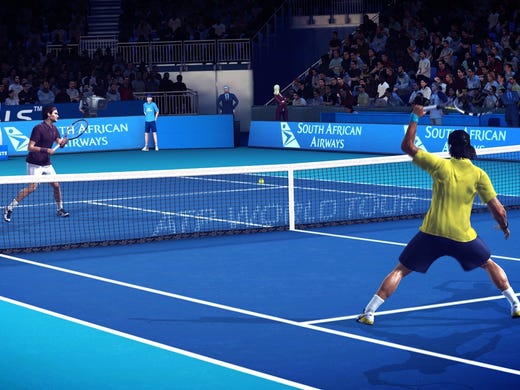MELBOURNE — In sports, the emphasis is often on the younger, but in a continuing tennis trend from last year the focus of the Australian Open men’s competition remains firmly planted on three over-30 former champions.
Key to the prognostication efforts wondering as to who is the favorite to win this year’s title are defending champion Roger Federer, at 36 the senior citizen of the threesome, and world No. 1 Rafael Nadal, five year’s Federer’s junior.
Federer and Nadal enter this year’s tournament as the only two men capable of leaving Melbourne as the top-ranked player in the world. Nadal only has to reach the quarterfinals to maintain No. 1 status, while Federer can overtake the Spaniard if he wins the title and Nadal loses before the quarters.
A relevant alternate in the prediction game is 30-year-old Novak Djokovic, already a six-time Australian Open champion. Djokovic, however, will be making his first appearance since Wimbledon after sitting out the second-half of last season nursing a right elbow injury.
While all are a fine examples of why not to write-off the more experienced athlete too soon, even Federer questioned his privileged billing at the Australian Open on Sunday.
"With age, I feel like I play down my chances just because I don’t think a 36-year-old should be a favorite of a tournament. It should not be the case," said Federer, who will play Aljaz Bedene of Slovenia in the first round. "That’s why I see things more relaxed at a later stage of my career."
MORE FROM AUSTRALIA
STEPHENS: Hoping to up her game after Grand Slam breakout in 2017
NAMESAKE: Billie Jean King backs call to rename Margaret Court Arena
Last year, Federer arrived in Australia after being benched with a knee injury the previous six months, and with little expectations. After winning the Australian Open — which he refers to as "the tournament of the year for me, no doubt about it" — and Wimbledon last season, he’s in the hunt to become the only man to win a 20th career Grand Slam singles trophy if he successfully defends his title this fortnight.
"If you’re in the draw, you give yourself a chance," said Federer, who has won five Australian titles. "That’s what happened for me last year. It’s just great to be back."
Nadal, like Federer, also came into the 2017 Australian underplayed due to a a left wrist injury that marred the second-half of his previous season. He led Federer by a service break in the fifth-set of the final before he surrendered the first major of the year to the Swiss.
In the end, Nadal put forth a brilliant 2017 campaign. He became the first man to win the same Grand Slam title on 10 occasions at the French Open, picked up his 16th Grand Slam trophy at the U.S. Open, and returned to the top ranking to become the oldest year-end No. 1 in the 45-year history of the ATP rankings.
"It’s better to start No. 1 than No. 20," said Nadal with a smile. "I’m being honest. That’s the real thing."
"(But) everyone starts (the new year) from zero," he added. "I start from zero again. I just hope to be healthy and competitive again."
If Nadal, who plays his opening match against Victor Estrella Burgos of the Dominican Republic, can win a second career Australian Open title this year — he won his first in 2009 — he would become the only man in the Open Era to win at least twice at each of the four majors.
On Saturday, the 14th-seeded Djokovic appeared happy to be making his return to the court, but provided sketchy-to-no information as to what the actual elbow injury was diagnosed as, whether the problem is completely behind him, and whether further medical action might eventually be needed.
What is known is that along with his two coaches — Radek Stepanek on a daily basis, and Andre Agassi as the on-occasion guru — Djokovic has condensed his service motion in deference to the elbow problem.
The possibility of Djokovic picking up a record seventh Australian Open title and overall 12th major trophy is hanging in the balance here. But the good news is he was cleared for action by his medical team.
"It was a strange feeling for me, obviously, not to be able to compete for six months," said Djokovic, who starts his Australian campaign against American Donald Young. "The fire, passion and love for the sport still burns inside.
"I do feel young inside, you know. Even though by some people’s opinion when you cross 30, you’re not young anymore. ... Roger and Rafa’s age is just a number, especially in Roger’s case."
Stan Wawrinka, 32, who won the first of his three Grand Slam titles at the Australian Open in 2014, is also returning to the tour following knee surgery and having not played since Wimbledon.
The ninth-seeded Wawrinka wasn’t sure he’d be ready to play, but took a chance in flying to Melbourne to practice and see how he felt. For now, he’s planning on facing Ricardas Berankis of Lithuania in the first round, but isn’t predicting past that match.
"I know I’m not at the level I want to be this year because it’s a long process to get there," he said. "But I’m happy with the way the knee is handling."
Hunger to compete and win, and a positive outlook are given necessities to becoming — and continuing to be — competitive champions. As the not yet over-the-hill Djokovic succinctly put it on Saturday, "Everything is possible really."






























































































Join the Nation's Conversation
To find out more about Facebook commenting please read the Conversation Guidelines and FAQs